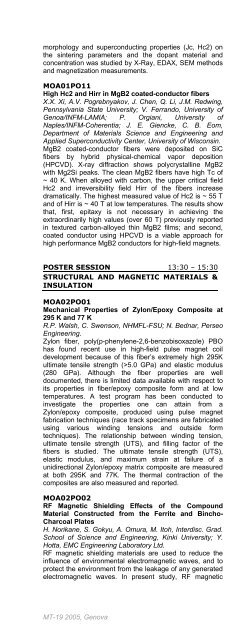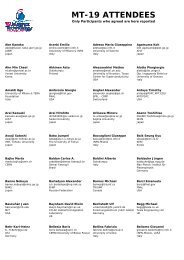Click here to download the abstract booklet in pdf format - MT19 - Infn
Click here to download the abstract booklet in pdf format - MT19 - Infn
Click here to download the abstract booklet in pdf format - MT19 - Infn
You also want an ePaper? Increase the reach of your titles
YUMPU automatically turns print PDFs into web optimized ePapers that Google loves.
morphology and superconduct<strong>in</strong>g properties (Jc, Hc2) on<br />
<strong>the</strong> s<strong>in</strong>ter<strong>in</strong>g parameters and <strong>the</strong> dopant material and<br />
concentration was studied by X-Ray, EDAX, SEM methods<br />
and magnetization measurements.<br />
MOA01PO11<br />
High Hc2 and Hirr <strong>in</strong> MgB2 coated-conduc<strong>to</strong>r fibers<br />
X.X. Xi, A.V. Pogrebnyakov, J. Chen, Q. Li, J.M. Redw<strong>in</strong>g,<br />
Pennsylvania State University; V. Ferrando, University of<br />
Genoa/INFM-LAMIA; P. Orgiani, University of<br />
Naples/INFM-Co<strong>here</strong>ntia; J. E. Giencke, C. B. Eom,<br />
Department of Materials Science and Eng<strong>in</strong>eer<strong>in</strong>g and<br />
Applied Superconductivity Center, University of Wiscons<strong>in</strong>.<br />
MgB2 coated-conduc<strong>to</strong>r fibers were deposited on SiC<br />
fibers by hybrid physical-chemical vapor deposition<br />
(HPCVD). X-ray diffraction shows polycrystall<strong>in</strong>e MgB2<br />
with Mg2Si peaks. The clean MgB2 fibers have high Tc of<br />
~ 40 K. When alloyed with carbon, <strong>the</strong> upper critical field<br />
Hc2 and irreversibility field Hirr of <strong>the</strong> fibers <strong>in</strong>crease<br />
dramatically. The highest measured value of Hc2 is ~ 55 T<br />
and of Hirr is ~ 40 T at low temperatures. The results show<br />
that, first, epitaxy is not necessary <strong>in</strong> achiev<strong>in</strong>g <strong>the</strong><br />
extraord<strong>in</strong>arily high values (over 60 T) previously reported<br />
<strong>in</strong> textured carbon-alloyed th<strong>in</strong> MgB2 films; and second,<br />
coated conduc<strong>to</strong>r us<strong>in</strong>g HPCVD is a viable approach for<br />
high performance MgB2 conduc<strong>to</strong>rs for high-field magnets.<br />
POSTER SESSION 13:30 – 15:30<br />
STRUCTURAL AND MAGNETIC MATERIALS &<br />
INSULATION<br />
MOA02PO01<br />
Mechanical Properties of Zylon/Epoxy Composite at<br />
295 K and 77 K<br />
R.P. Walsh, C. Swenson, NHMFL-FSU; N. Bednar, Perseo<br />
Eng<strong>in</strong>eer<strong>in</strong>g.<br />
Zylon fiber, poly(p-phenylene-2,6-benzobisoxazole) PBO<br />
has found recent use <strong>in</strong> high-field pulse magnet coil<br />
development because of this fiber’s extremely high 295K<br />
ultimate tensile strength (>5.0 GPa) and elastic modulus<br />
(280 GPa). Although <strong>the</strong> fiber properties are well<br />
documented, t<strong>here</strong> is limited data available with respect <strong>to</strong><br />
its properties <strong>in</strong> fiber/epoxy composite form and at low<br />
temperatures. A test program has been conducted <strong>to</strong><br />
<strong>in</strong>vestigate <strong>the</strong> properties one can atta<strong>in</strong> from a<br />
Zylon/epoxy composite, produced us<strong>in</strong>g pulse magnet<br />
fabrication techniques (race track specimens are fabricated<br />
us<strong>in</strong>g various w<strong>in</strong>d<strong>in</strong>g tensions and outside form<br />
techniques). The relationship between w<strong>in</strong>d<strong>in</strong>g tension,<br />
ultimate tensile strength (UTS), and fill<strong>in</strong>g fac<strong>to</strong>r of <strong>the</strong><br />
fibers is studied. The ultimate tensile strength (UTS),<br />
elastic modulus, and maximum stra<strong>in</strong> at failure of a<br />
unidirectional Zylon/epoxy matrix composite are measured<br />
at both 295K and 77K. The <strong>the</strong>rmal contraction of <strong>the</strong><br />
composites are also measured and reported.<br />
MOA02PO02<br />
RF Magnetic Shield<strong>in</strong>g Effects of <strong>the</strong> Compound<br />
Material Constructed from <strong>the</strong> Ferrite and B<strong>in</strong>cho-<br />
Charcoal Plates<br />
H. Norikane, S. Gokyu, A. Omura, M. I<strong>to</strong>h, Interdisc. Grad.<br />
School of Science and Eng<strong>in</strong>eer<strong>in</strong>g, K<strong>in</strong>ki University; Y.<br />
Hotta, EMC Eng<strong>in</strong>eer<strong>in</strong>g Labora<strong>to</strong>ry Ltd.<br />
RF magnetic shield<strong>in</strong>g materials are used <strong>to</strong> reduce <strong>the</strong><br />
<strong>in</strong>fluence of environmental electromagnetic waves, and <strong>to</strong><br />
protect <strong>the</strong> environment from <strong>the</strong> leakage of any generated<br />
electromagnetic waves. In present study, RF magnetic<br />
shield<strong>in</strong>g degree SDh of a compound material, such as a<br />
b<strong>in</strong>cho-charcoal plate superimposed by ferrite plate, is<br />
measured by use of <strong>the</strong> measur<strong>in</strong>g cell for <strong>the</strong> near field<br />
(46 mm wide, 46 mm <strong>in</strong> height, 55 mm deep, 2 mm thick).<br />
The value of SDh for a ferrite plate was found <strong>to</strong> <strong>in</strong>crease<br />
as <strong>the</strong> frequency <strong>in</strong>creased over range from 1 MHz (SDh at<br />
1 MHz: 20 dB) <strong>to</strong> 20 MHz (SDh at 20 MHz: 35 dB), and <strong>to</strong><br />
decrease <strong>in</strong> frequency region from 20 MHz <strong>to</strong> 1 GHz (SDh<br />
at 1 GHz: 9 dB). However, it was found that <strong>the</strong> value of<br />
SDh for <strong>the</strong> b<strong>in</strong>cho-charcoal plate is held at 0 dB <strong>in</strong><br />
frequency range of 1 MHz - 8 MHz, and <strong>the</strong>n <strong>in</strong>creases<br />
over <strong>the</strong> frequency range of 8 MHz - 1 GHz (SDh at 1 GHz:<br />
35 dB). Here, b<strong>in</strong>cho-charcoal is obta<strong>in</strong>ed from very hard<br />
oak, s<strong>in</strong>tered under high temperature conditions. The RF<br />
magnetic shield<strong>in</strong>g characteristics were found <strong>to</strong> be<br />
improved by us<strong>in</strong>g <strong>the</strong> compound material, <strong>in</strong> <strong>the</strong> frequency<br />
region from 7 MHz <strong>to</strong> 1 GHz, that is, <strong>the</strong> value of SDh is<br />
held at approximately 35 dB on <strong>the</strong>se wide frequency<br />
region. The present paper exam<strong>in</strong>es <strong>the</strong> effects of RF<br />
electromagnetic shield<strong>in</strong>g on <strong>the</strong> compound materials. This<br />
<strong>in</strong>cludes <strong>the</strong> RF magnetic and electric shield<strong>in</strong>g degrees,<br />
SDh and SDe, as a function of frequency, and <strong>the</strong> SDh and<br />
SDe as a function of RF power.<br />
MOA02PO03<br />
An <strong>in</strong>novat<strong>in</strong>g <strong>in</strong>sulation for Nb3Sn W<strong>in</strong>d & React<br />
coils: electrical tests<br />
L. Quettier, J.M. Rey, F. Rondeaux, CEA Saclay; A.<br />
Puigsegur, E. Prouzet, Institut Européen des Membranes -<br />
CNRS Montpellier.<br />
If Nb3Sn is <strong>the</strong> best superconduc<strong>to</strong>r candidate for <strong>the</strong><br />
realisation of high field magnets (>10-11 Teslas), its<br />
implementation rema<strong>in</strong>s delicate because of <strong>the</strong> great<br />
brittleness of material after <strong>the</strong> heat treatment necessary <strong>to</strong><br />
<strong>the</strong> <strong>format</strong>ion of Nb3Sn compounds. The conventional<br />
<strong>in</strong>sulation for Nb3Sn W<strong>in</strong>d & React coils requires <strong>to</strong><br />
perform, after <strong>the</strong> heat treatment, a vacuum res<strong>in</strong><br />
impregnation, which adds <strong>to</strong> <strong>the</strong> cost and raises failure risk.<br />
We have proposed a one-step <strong>in</strong>novat<strong>in</strong>g ceramic<br />
<strong>in</strong>sulation deposited directly on <strong>the</strong> un-reacted conduct<strong>in</strong>g<br />
cable. After <strong>the</strong> heat treatment necessary <strong>to</strong> <strong>the</strong> <strong>format</strong>ion<br />
of <strong>the</strong> Nb3Sn, we obta<strong>in</strong> a coil hav<strong>in</strong>g a mechanical<br />
cohesion, while ma<strong>in</strong>ta<strong>in</strong><strong>in</strong>g a proper conduc<strong>to</strong>r position<strong>in</strong>g<br />
and a suitable electric <strong>in</strong>sulation. We have shown that<br />
us<strong>in</strong>g this <strong>in</strong>sulation <strong>in</strong> a coil manufacture process doesn’t<br />
affect <strong>the</strong> electrical properties of <strong>the</strong> Nb3Sn wires. A<br />
solenoid of small dimensions (9 * 20 turns on an <strong>in</strong>ternal<br />
diameter of 22 mm) has produced a magnetic field of 3.8 T<br />
under 740 A. It was tested with success <strong>in</strong> high external<br />
magnetic fields: <strong>the</strong> quench limits have been imposed by<br />
<strong>the</strong> strand and <strong>the</strong> <strong>in</strong>sulation was not damaged.<br />
MOA02PO04<br />
The Structure and Magnetic Properties of<br />
Hydroextruded Dysprosium<br />
A. Bula<strong>to</strong>v, M. Lazareva, M. Tikhonovsky, N. Chernyak,<br />
National Science Center "Kharkov Institute of Physics &<br />
Technology" (NSC KIPT).<br />
The low-temperature coll<strong>in</strong>ear ferromagnetic Dy that has<br />
high saturation flux density is a promis<strong>in</strong>g material for<br />
build<strong>in</strong>g magnetic flux concentra<strong>to</strong>rs for various cryogenic<br />
magnetic systems. An impediment for its employment <strong>in</strong><br />
<strong>the</strong> polycrystall<strong>in</strong>e isotropic state is <strong>the</strong> giant<br />
magne<strong>to</strong>crystall<strong>in</strong>e anisotropy. The problem has been<br />
resolved of crystall<strong>in</strong>e structure control throughout <strong>the</strong><br />
mass volume. The review of <strong>the</strong> experimental results<br />
<strong>in</strong>dicated that: 1.As a result of <strong>the</strong> plastic stra<strong>in</strong> obta<strong>in</strong>ed<br />
via <strong>the</strong> technique of Dy room temperature hydroextrusion,<br />
<strong>the</strong> favorable crystallographic gra<strong>in</strong> orientation<br />
MT-19 2005, Genova 26



